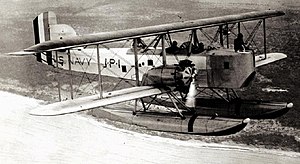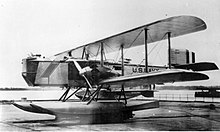avia.wikisort.org - Aeroplane
The Douglas T2D was an American twin-engined torpedo bomber contracted by the military, and required to be usable on wheels or floats, and operating from aircraft carriers. It was the first twin-engined aircraft to be operated from an aircraft carrier.
| T2D | |
|---|---|
 | |
| Douglas T2D-1 of VP-1 | |
| Role | Torpedo bomber |
| Manufacturer | Douglas Aircraft Company |
| First flight | 27 January 1927 |
| Introduction | 1927 |
| Retired | 1937 |
| Primary user | United States Navy |
| Number built | 31 |
Development and design
In 1925, the United States Navy's Bureau of Aeronautics designed a twin-engined torpedo bomber aircraft, intended to have greater performance than contemporary single-engined aircraft. A single prototype was built by the Naval Aircraft Factory as the XTN-1, which was quickly followed by three identical aircraft built by Douglas, the T2D-1.
The XTN/T2D was a large two bay biplane, capable of easy conversion between floats and wheels, and carrying a crew of four.
Operational history
The first three T2D-1's were delivered to the torpedo bomber squadron VT-2 on 25 May 1927, being used for successful trials aboard the aircraft carrier Langley. A further nine T2D-1's were ordered in 1927, these normally being operated as floatplanes, partly owing to criticism from the Army of the Navy operating large land-based bombers, and partly as its large size prevented Langley from embarking a full airwing.[2]
A further 18 aircraft were ordered in June 1930 as patrol floatplanes, being designated P2D-1. These were operated by Patrol Squadron VP-3 in the Panama Canal Zone until they were replaced by Consolidated PBYs in 1937.
Variants

- XTN-1
- Original prototype built by Naval Aircraft Factory. One built.
- T2D-1
- Production aircraft, convertible torpedo bomber/patrol floatplane, powered by Wright R-1750 Cyclones. 12 built.
- P2D-1
- Dedicated patrol floatplane. Fitted with twin tail for improved engine out performance and powered by two Wright R-1820 Cyclones. 18 built.
Operators
 United States
United States
- United States Navy
Specifications (T2D-1 landplane / floatplane)
Data from McDonnell Douglas aircraft since 1920 : Volume I[3]
General characteristics
- Crew: 4
- Length: 42 ft (13 m) (landplane)
- 44 ft 4 in (13.51 m) (floatplane)
- Wingspan: 57 ft (17 m)
- Height: 15 ft 11 in (4.85 m) (landplane)
- 44 ft 4 in (13.51 m) (floatplane)
- Wing area: 886 sq ft (82.3 m2)
- Empty weight: 6,011 lb (2,727 kg) (landplane)
- 6,528 lb (2,961 kg) (floatplane)
- Gross weight: 9,986 lb (4,530 kg) (landplane)
- 10,503 lb (4,764 kg) (floatplane)
- Max takeoff weight: 10,523 lb (4,773 kg) (landplane)
- 11,040 lb (5,010 kg) (floatplane)
- Powerplant: 2 × Wright R-1750 Cyclone 9-cylinder air-cooled radial piston engines, 525 hp (391 kW) each
- Propellers: 3-bladed fixed-pitch metal propellers
Performance
- Maximum speed: 125 mph (201 km/h, 109 kn) at sea level (landplane)
- 124 mph (108 kn; 200 km/h) at sea level (floatplane)
- Range: 457 mi (735 km, 397 nmi) (landplane)
- 384 mi (334 nmi; 618 km) (floatplane)
- Ferry range: 454 mi (731 km, 395 nmi) (floatplane)
- Service ceiling: 13,830 ft (4,220 m) (landplane)
- 11,400 ft (3,500 m) (floatplane)
- Time to altitude: 5,000 ft (1,500 m) in 5 minutes 54 seconds (landplane)
- 5,000 ft (1,500 m) in 7 minutes 42 seconds (floatplane)
- Wing loading: 11.4 lb/sq ft (56 kg/m2) (landplane)
- 11.9 lb/sq ft (58 kg/m2) (floatplane)
- Power/mass: 0.105 hp/lb (0.173 kW/kg) (landplane)
- 0.1 hp/lb (0.16 kW/kg) (floatplane)
Armament
- Guns: *2 × .30 in (7.62 mm) M1919 Browning machine guns
- Bombs: *1 ×1,618 lb (734 kg) torpedo or equivalent bombload
References
- Donald, David (1997). The complete encyclopedia of world aircraft (Reprinted ed.). New York, NY: Barnes & Noble Books. ISBN 9780760705926.
- Francillon, René J. (1988). McDonnell Douglas aircraft since 1920 : Volume I. London: Naval Institute Press. pp. 91–97. ISBN 0870214284.
External links
| Wikimedia Commons has media related to Douglas T2D. |
На других языках
- [en] Douglas T2D
[fr] Douglas T2D
Le Douglas T2D est un bombardier bimoteur américain dont les spécifications émises par les militaires prévoient qu'il puisse être doté d'un train à roues ou de flotteurs et mis en œuvre depuis un porte-avions. Il sera en fait le premier avion bimoteur à opérer depuis un porte-avions[1].[it] Douglas T2D
Il Douglas T2D era un bombardiere aerosilurante, bimotore, capace di operare dai ponti delle portaerei, costruito nella seconda metà degli anni venti. Originariamente concepito dalla Naval Aircraft Factory di Philadelphia, venne riprogettato dagli ingegneri statunitensi John Knudsen Northrop e Edward H. Heinemann per conto della Douglas Aircraft Company. Costruito in due versioni principali per un totale di 31 esemplari, rimase in servizio per compiti di pattugliamento aeromarittimo fino al 1937.[2]Другой контент может иметь иную лицензию. Перед использованием материалов сайта WikiSort.org внимательно изучите правила лицензирования конкретных элементов наполнения сайта.
WikiSort.org - проект по пересортировке и дополнению контента Википедии